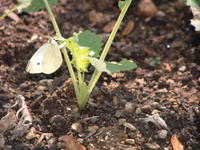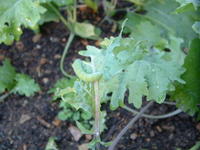If you’re growing Cole crops such as cabbage, broccoli, kale, collards, and brussels sprouts, your garden is probably a habitat for the cabbage butterfly and its troublesome offspring, the infamous cabbage worm.
Identifying Cabbage Butterflies at Work
 You’ve seen the small white butterflies flying around your garden and stopping momentarily to land on a plant here and there. That split second is all the time that it takes for the moth like insect to deposit a single egg on each plant that it visits. The picture to the left shows a cabbage butterfly caught in the act of placing an egg on the underside of a kale leaf.
You’ve seen the small white butterflies flying around your garden and stopping momentarily to land on a plant here and there. That split second is all the time that it takes for the moth like insect to deposit a single egg on each plant that it visits. The picture to the left shows a cabbage butterfly caught in the act of placing an egg on the underside of a kale leaf.
The egg will quickly hatch into a caterpillar who will commence to devouring as much of the host plant as possible. Despite the significant damage that they can cause, this pest is relatively easy to control with organic gardening techniques.
Controlling Cabbage Worms in the Garden
Your simplest defense is to just hand pick and discard these crawling pests. While their green color helps them blend in, the damage that they create and the dark green droppings that they leave behind make it easy to track them down.
For larger gardens or severe infestations there are several organic pesticides that can be applied to control cabbage worms. My preferred caterpillar control is Bacillus Thuringiensis, commonly known as Bt.
The Organic BT Solution to Eliminate Cabbage Pests

The great thing about Bt is that it only affects insects that are in the caterpillar stage. It consists of a naturally occurring bacteria that is deadly to cabbage worms. Once they consume a part of a plant treated with Bt, the worm will stop feeding and shortly thereafter it will die.
Bt is usually sold in a liquid form which is mixed with water and sprayed onto the foliage of the plants that are under attack. This organic product is safe and can be applied right up until the time of harvest. Bt works and offers complete control over many types of caterpillars.



3 Responses
I have found that seeding dill around these plants will keep the cabbage white butterflies away (and subsequently the worms as well).
Hello Kenny,
Thanks for the article on Cabbage Worms. I had seen the white moths, but found them attractive. But when I woke up this morning, the worms had eaten every leaf off the oregano, and large sections of the lettuce.
But I found the worms, and will keep a close eye on the plants every morning.
Thank you so much for your in-depth blog.
Philip,
Hello Kenny,
Thanks for the article on Cabbage Worms. I had seen the white moths, but found them attractive. But when I woke up this morning, the worms had eaten every leaf off the oregano, and large sections of the lettuce.
But I found the worms, and will keep a close eye on the plants every morning.
Thank you so much for your in-depth blog.
Philip,